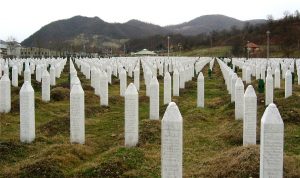“Srebrenica Genocide” Narrative Bites the Dust

All Global Research articles can be read in 51 languages by activating the “Translate Website” drop down menu on the top banner of our home page (Desktop version).
To receive Global Research’s Daily Newsletter (selected articles), click here.
Follow us on Instagram and Twitter and subscribe to our Telegram Channel. Feel free to repost and share widely Global Research articles.
***
The phoney “genocide” in Srebrenica marks its twenty-seventh anniversary on 11 July this year. As politically convenient fabrications go, it must be admitted that it has been extraordinarily effective in serving the purposes for which it was created, but this year’s rather low key observances suggest that it is at the end of its cycle.
There are two heavy hints to that effect. The genocide resolution illegally tabled in the UN General Assembly by Bosnia’s sectarian central government representative Sven Alkalaj, in disregard of the veto placed by the country’s Serb entity, Republika Srpska, has gone practically unnoticed and uncommented by major Western media and political figures. By contrast, in the past, it would have triggered unendurable evocations of the saga of “8,000 men and boys” and their unique suffering.
Concomitantly, as the narrative faces a deficit of global attention, this year simple mathematical realities are reducing the formerly massive funerals of exhumed “victims” to barely a trickle. The annual 11 July interments at the Srebrenica Memorial Centre in Potocari are the centrepiece of the Srebrenica cult. But the recklessness of past years, when every July hundreds of caskets would be buried in tear-jerking ceremonies, is finally taking its toll. As the total number of Srebrenica burials approaches the mandated total of about 8,000, reducing the annual count from hundreds to just a few dozen is the only way to ensure that the drama could be stretched out for a few more years.
Image on the right: Gravestones at the Potočari genocide memorial near Srebrenica (Source: Wikimedia Commons)
Srebrenica is the oddest of genocides for several interesting reasons. For one, it went largely unnoticed for over two years until it was finally “discovered” and publicised at an international conference seemingly convened for that purpose in 1997 in Sarajevo. The supposed genocide went undetected also in the confidential intelligence reports of Sarajevo military and civilian authorities, the aggrieved side which should have been the first to become aware of it. The damning reportswere assembled, perhaps inadvertently, by the Hague Tribunal, the very body whose tendentious verdicts these reports discredit.
Equally curious is the forensic situation, which is completely at odds with what should be expected if a genocide had taken place. It does not support the standard narrative and Hague Tribunal claims which follow that narrative closely. It must be deemed extraordinary that in two and a half decades physical evidence in the form of 8,000 bodies has completely failed to materialise. Exhumation autopsy reports, the only relevant indicator, point to the presence of about 1,920 bodies in Srebrenica related mass graves, but of those only half, or roughly a thousand, exhibit a pattern of injury consistent with execution. The majority of the remainder have unmistakable combat injuries, pointing away from the execution of captured prisoners. That is consistent with known facts on the ground after 11 July 1995. Following the fall of Srebrenica, a large military force from within the supposedly “demilitarised” enclave conducted an armed break-out over a sixty-mile stretch of Serbian territory, along the way engaging Serbian forces in fierce combat and sustaining heavy losses.
The quiet shelving, after 2001, of autopsy-based Srebrenica evidence came in the form of Hague Tribunal’s rather brash attempt to substitute fluidly defined “DNA evidence” for hard forensic data, once it became clear that traditional methods would yield nowhere near the required 8,000 bodies.
From a juridical standpoint, even if the claimed victim figures were granted, a “genocide” whose organisers could not be identified (as freely admitted by ICTY judge Jean-Claude Antonetti in his separate opinion in the Tolimir case), which assuming anything like it had occurred was limited to the municipal level, and whose alleged death toll was only 8,000 in a population of over three million, literally beggars belief. And even more so, ICTY’s preposterous judgment that two weeks later the killing of three individuals in the neighbouring enclave of Zepa also constituted “genocide” because the victims were key community figures without whom the life of the surviving 5,000 inhabitants was rendered unsustainable.
The politically inspired “genocide” in Srebrenica stands out also because it is the only known occurrence of its type that, in the process of supposedly owning up to the failures that led to it, precipitated a world-wide slaughter of literally over a hundred times greater magnitude.
The stark fact is that the utter and most likely deliberate misrepresentation of what happened in Srebrenica, amplified by a powerful media and political machine, was behind the creation of the odious R2P “humanitarian intervention” doctrine. The scope and impact of that mendacious construct are well enough known to require elaboration. Suffice it to say that from Kosovo to Iraq, Libya, and Syria, the interventionist rationale ultimately rooted in fabrications generated around Srebrenica has destroyed an estimated two million lives, enabled imperialist plunder on an epic scale, and led to seemingly irreparable devastation of international law through the pernicious activity of the Hague Tribunal and subsequently its successor, the ICC.
Srebrenica has been an unmitigated human disaster because of the effects of its cynical misuse by the global powers that be, for the basest of purposes. Weaponised in Bosnia as a generator of vicious inter- communal enmity and enduring instability, globally it has wreaked death and destruction on an unprecedented scale, all the more appallingly because of the humanitarian veneer put on to conceal the utter cynicism and amorality of the perpetrators.
The gradual but inexorable disintegration of the phoney Srebrenica narrative should be welcomed by every person committed to honesty and truth.
*
Note to readers: Please click the share buttons above or below. Follow us on Instagram and Twitter and subscribe to our Telegram Channel. Feel free to repost and share widely Global Research articles.
Stephen Karganovic is president of “Srebrenica Historical Project,” an NGO registered in the Netherlands to investigate the factual matrix and background of events that took place in Srebrenica in July of 1995.
He is a regular contributor to Global Research.


